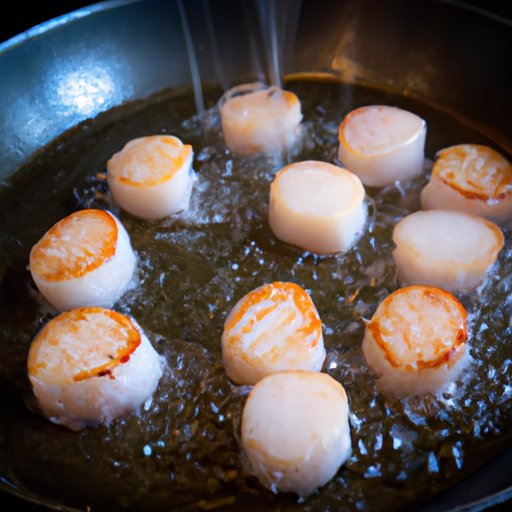
I. Introduction
Welcome to our comprehensive guide to perfectly cooked scallops. This article is intended for seafood lovers of all levels who want to learn the best ways to cook scallops and avoid overcooking this delicate seafood.
Scallops are a delicious and highly versatile seafood that can be a bit tricky to cook. Overcooking them can turn them rubbery and tough, while undercooking can leave them raw and unsafe to eat. In this article, we will explore the best ways to cook scallops and provide tips and tricks to ensure your scallops come out perfectly every time.
II. A step-by-step guide to perfectly cook scallops: Tips, tricks and timing
Before you begin to cook your scallops, it is important to properly prepare them. Start by patting them dry with a paper towel to remove any excess moisture. This will help them brown evenly.
There are several ways to cook scallops, including sautéing, searing, broiling, and grilling. Each method has different recommended cooking times:
- Sautéed scallops: 2-3 minutes per side
- Searing scallops: 1-2 minutes per side
- Broiled scallops: 4-5 minutes per side
- Grilled scallops: 2-3 minutes per side
In general, scallops should be cooked until they are just barely opaque in the center. They will continue to cook a bit after they are removed from heat, so be careful not to overcook them.
Additional tips to ensure perfect scallops include:
- Use a nonstick pan or well-seasoned cast iron skillet to prevent sticking
- Cook scallops in a single layer to ensure even cooking
- Season scallops with salt and pepper before cooking
III. The do’s and don’ts of cooking scallops: How to avoid overcooking your seafood
Overcooking scallops can ruin the dish and leave them tough and rubbery. Signs of overcooked scallops include a dry, chewy texture and a white, opaque appearance throughout.
To avoid overcooking scallops, start with a dry scallop and cook them quickly over high heat. Avoid crowding the pan or flipping them too often.
IV. The perfect scallop recipe: How to cook scallops in 10 minutes or less
If you’re looking for a quick and easy scallop recipe, try this:
- Heat a nonstick pan over high heat
- Add scallops and cook for 2-3 minutes on each side, until just barely opaque in the center
- Add a splash of white wine or lemon juice and scrape up any brown bits on the bottom of the pan
- Serve hot, garnished with fresh herbs if desired
For side dishes, try serving your scallops with a simple green salad or rice pilaf.
V. Chefs’ secrets: How to tell when your scallops are cooked to perfection
Expert chefs use a few tricks to tell when scallops are cooked through:
- Press gently on the center of the scallop with your finger. If it feels slightly firm and does not indent, it is done.
- Cut a small slit in the center of the scallop and check to see that it is barely opaque in the center.
Remember, scallops will continue to cook a bit after they are removed from the heat, so err on the side of undercooking rather than overcooking.
VI. The science behind scallop cooking: Why timing is everything
Scallops have a high protein content, which makes them cook quickly. Overcooking them causes the proteins to tighten and contract, resulting in a tough texture.
Additionally, scallops release a lot of liquid as they cook, which can create a steamy environment that can affect cooking times.
For perfectly cooked scallops every time, be sure to keep an eye on the timing and avoid overcooking them.
VII. From searing to baking: Different ways to cook scallops and which to choose based on your preferences
There are several ways to cook scallops, each with its own advantages and disadvantages:
- Sautéing: Quick and easy, but can be prone to sticking
- Searing: Ideal for a crispy crust, but must be cooked quickly to avoid overcooking
- Broiling: Creates a nice crust, but can dry out the scallops if overcooked
- Grilling: Adds a nice smoky flavor, but can be tricky to get the timing right
Consider your personal preferences when choosing a cooking method for scallops. If you love a crispy crust, searing may be the way to go. If you want a bit of smokiness in your seafood, grilling is a great option.
VIII. Conclusion
Scallops are a delicious and delicate seafood that can be a bit tricky to cook perfectly. To achieve tender and flavorful scallops, start with dry scallops, use high heat, and avoid overcooking.
Whether you’re a seafood beginner or a seasoned home chef, we hope this guide has provided you with the tips and tricks you need to cook perfect scallops every time.




